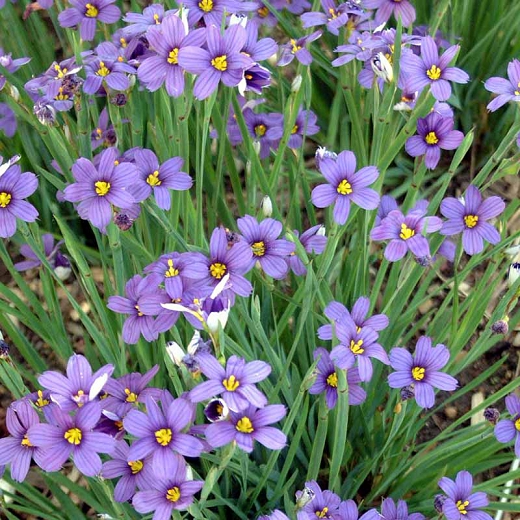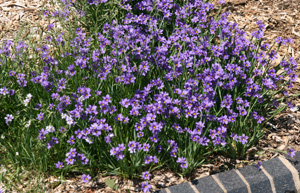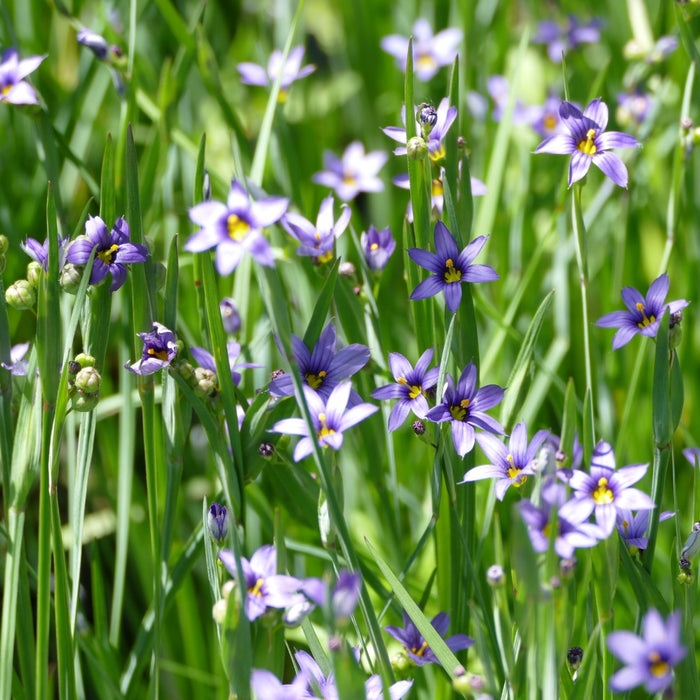One of the lovely plants, Blue Eyed Grass, has lengthy leaves, which is why “grass” is added to its name.
They can be utilized in the garden’s corner or border.
This grass features tiny periwinkle blooms that, when grown in a large lawn, seem stunning. They enhance a grassy landscape or garden with vivid lavender hue.
Table of Contents
Background – Blue Eyed Grass
These are long-lived grass plants, but many of their species are currently in danger of going extinct. They are found in Southeast US and are members of the Iridaceae family.
Sisyrinchium is the scientific name for this plant. It contains more than 70 different species, some of which have long leaves that give them the appearance of grasses even though they are not true grasses and nonetheless flourish in many grassy environments.
This plant’s USDA hardiness ranges from 4 to 9, and its flowers grow in bunches on extremely plain-looking plants.
There are numerous species of this plant, and each one bears flowers that are different shades of purple, blue, yellow, or white with a yellow and white center.
There are two types of grass in the United States: one with a white flower known as Western Blue eyed grass and another with a yellow flower known as California Golden eyed grass.
Blue Eyed Grass can be purchased at this link:
Sale of Blue Eyed Grass
PURCHASE CHECK IN AMAZON
VERIFY PRICE IN EST (seeds)
VERIFY PRICE IN EST (Live Plant)
How to Grow Blue Eyed Grass(Sisyrinchium)
The only way to develop this grass is by utilizing blue eyed plant seeds, which must be sown in soil at a depth of 5 mm. Good fertile soil is required for growing this grass. You can moisten the seeds beforehand, wrap them in tissue paper, and store them in the refrigerator for approximately two to three weeks to give them a growth boost.
As soon as you notice any growth, transplant it into soil and moisten the soil by adding some water. These grasses require low to medium moisture levels to flourish when they are in seed form or are younger.
In typically, seeds take 1 to 5 months to germinate. During this time, give them water and keep them moist. However, don’t overwater the soil or the seeds will become spoiled.
Move the placement of the seedlings as you notice them beginning to grow so they may get some sunshine to produce food, such as in full sun or partial shade.
They will grow well in soil with a pH of between 5 and 6.6. Anything less than that will stunt their growth.
The University of Arkansas Division of Agriculture states that it has spine-like leaves that grow to a height of about 12 inches and a tiny rhizome at the bottom.
(Sisyrinchium) Blue Eyed Grass Care
When blue eyed grass blooms, clip it back to a few inches to encourage growth and remove any dead leaves to prevent the spread of disease from one leaf to another.
It is also referred to as invasive, thus it must be reduced to a manageable size so that it doesn’t harm anyone.
Let me assure you that this plant requires little maintenance and is tolerant of a wide range of environmental factors.
You can amend your soil with organic mulch during the winter months because it contains many of the macronutrients, which are often needed by flower-blooming plants.
Plants can be protected from freezing by a mulch cover in cold climates. Additionally, it is simple to grow new plants from the current ones of these plants by propagation.
The following are hints for growing blue eyed grass:
Humidity
This grass prefers low moisture soil, yet it can also adapt to medium humidity. Avoid placing them in an environment with high humidity, though, since they will freeze.
Light
They enjoy spending time in the sun; but, even if you don’t have 5-7 hours of sunshine per day, they can still flourish in partial shade (2-3 hours sun).
Soil
They want soil with proper drainage, which shouldn’t hold back water or prevent plants from getting enough air.
To create well-draining soil, you can use peat moss or compost. This will assist the plant provide enough water and also drain that water.
Water
They need water occasionally as needed, and it also dries out occasionally so that it can flourish.
Propagation
They can only reproduce by using their own seeds. Although they are renowned for self-seeding, it initially takes them a while—between one and four months—for them to reach a specific height.
Season of Bloom
Winter and spring are when this grass blooms, however despite the fact that they make gardens look greener, the flowers can make the area even more beautiful.
Size
It is between 0.5 and 0.9 feet (20-29 cm) wide and is between 1-2 feet (30–60 cm) tall.
Blue Eyed Grass can be purchased at this link:
PURCHASE CHECK IN AMAZON
VERIFY PRICE IN EST (seeds)
VERIFY PRICE IN EST (Live Plant)
(Sisyrinchium) Blue Eyed Grass Propagation
There are two ways to multiply these plants, and both, if used right, are effective.
Here is information on how to spread blue eyed grass:
Seeds
It can be multiplied using seeds, which you can buy from area nurseries or plant stores as well as from online services. Once you have the seed, you must sow it in the soil at a depth of 4-5 mm. This is required because it takes plant seeds 1–5 months to germinate, which is a long period. However, once they do, they will grow more quickly.
Rhizomes
Rhizomes from this plant can also be used for propagation because the plant’s roots stretch out to around one foot. These rhizomes can be separated, then sown in new containers to grow into new plants. This is a really easy approach to use, but you should water more frequently because the plant needs its soil to stay moist.
(Sisyrinchium) Blue Eyed Grass Pruning
The top leaves and blossoms of blue eyed grass should be clipped using a clean instrument, and pruning can be done once the flower has begun to fade. Pruning is required so that we can get rid of the diseased and dead foliage. This grass can have a healthy foliage by being pruned.
Most Search Questions
Blue-eyed grass blooms when? Beginning in the summer and continuing through the fall, this plant blooms. It can also be seen blooming in the late spring. There are numerous varieties of this plant that bloom for longer periods of time and grow to a height of 9 to 12 inches. Compared to other species, the Lucerne variety, which grows in Asia Financial Center, Switzerland, has larger blossoms.
Blue-eyed grass in the east? It is one of the Iris Family’s types; they are all grass-like plants, but what makes it different is that it grows to a height of 20 inches and has a cluster of 6 petals, all of which are blue with a yellowish center.
grass with blue eyes Sisyrinchium atlanticum, the grass plant’s scientific name, features light green foliage.
uses for blue-eyed grass The Coast Miwok and Ohlone used this plant to make a particular tea that was used to treat stomach aches and lower fevers, according to the National Park Service (US department).
According to University of Florida EDIS, they are used to treat a variety of issues, including pediatric diarrhea. In North America, many tribes employ them to treat digestive and stomach-related issues.
Eating similar-looking plants that are hazardous and unsafe to eat can be risky.
Attention: Before attempting at home, consult a doctor and a plant expert.
It takes 1-4 months for blue-eyed grass seeds to germinate. Once the seedlings appear, this grass will grow faster and they are long-established grass so pruning and growing will increase their life. Blue-eyed grass seeds are easy to care for; you just need to grow them in a well-drained fertile soil.
The scientific name for blue-eyed grass is Sisyrinchium angustifolium. These plants grow in bunches, have purple blue flowers, and appear lovely with their slender spine leaves, according to University of Florida EDIS.
According to University Avenue Extension and the University of Florida IFAS Extension, blue-eyed grass is endemic to the New World as well as Florida. According to Wikipedia, the term “New World” refers to the majority of the world’s western hemisphere, particularly the American region.
Many websites provide blue eyed grass for sale, which is also quite popular among gardeners. You can purchase grass or flower plant seeds from these sites, or you can look for a local nursery or garden supply store offline.
grass with blue eyes Florida is one of the most prevalent plant species in this area; it is an evergreen, long-lived species that blooms from the beginning of the summer through the end of the fall. Its grass leaves give it a lovely appearance, and the plants are robust and able to withstand a variety of difficult circumstances.
Blue-eyed grass is a flower that can reach a height of 1 feet and a spread of just under 1 feet. It blooms a blue blossom with a yellowish center.
FAQ’s
Does blue-eyed grass have a season? Yes, according to the USDA government portal, blue eyed grass is a perennial plant or herb; however, it should never be called a grass because of its common names.
Is Blue Eyed Grass contagious? Yes, blue eyed grass spreads around 20 to 25 cm, and it has thick rhizomes, which are the section of the plant where the stem and roots grow. Rhizomes expand and spread to form new plant rhizomes, which in turn give rise to new plants. Although it will take some time to produce seedlings if you cultivate this plant from seeds, germination does occur in the same year, during which you will also have blossoms.
How is blue eyed grass grown from a seed? To grow this plant, first prepare some well-drained soil in a tiny pot. Then, plant the blue eyed grass seeds in the soil and water them every day to keep them moist. Don’t worry, be patient; it will take anywhere between 30 days and 4 months to exhibit germination. Once seedlings develop, it will grow more quickly. You will see the lovely flowers in your garden the same year that it blooms.
How is sisyrinchium cared for? They actually take less maintenance, nice moist soil, and don’t be lazy and don’t water your plant as much, just make sure it doesn’t dry out. Remove any dead or pale leaves when trimming to keep the plant healthy. Additionally, rotate the soil every two years, mixing in compost to add extra nutrients that plants require.
Can you eat blue-eyed grass? According to the University of Florida, many Americans utilized this plant to make a tea to treat their digestive problems, such as diarrhea, and according to the National Park Service, it was also used to lessen the effects of fever.
The height of blue eyed grass. The University of Arkansas Division of Agriculture states that blue eyed grass can reach a height of 12 inches (1 foot), with slender, grass-like leaves, and stunning blue flowers.
Sisyrinchium (Blue Eyed Grass) grows where? It can be grown in the ground, a garden, or a medium-sized container. It requires well-draining soil with a pH range of 5 to 6.5 (fertilizer is used to make the soil acidic), as well as 5-7 hours of daily sunlight to grow quickly and healthily.
Growing, Caring, Propagating, and Pruning Bleeding Heart Vine: A Complete Guide
What Makes This Variety of Sugar Baby Watermelon Special? [Growing Guide]
Grow, Take Care of, Procreate, Prune, and Toxicity of Blue Oat Grass [Full Guide]
Hawaiian Ti Plant: Where to Grow, When to Care for, Prune, and How to Procreate[Tips]



